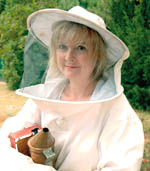Martha Kearney on her passion for beekeeping
Martha Kearney explains the joys, and travails of beekeeping


Oh no, not wax moth!' I was sitting in my BBC office, between interviews, when the bad news came through. There was a snigger from my colleagues at my slightly histrionic distress. Over the years, the team has become used to hearing about the travails of beekeeping. This latest problem came when my friend, who keeps her hive next to mine, discovered a wasp's nest under her colony. In late summer, wasps turn particularly vicious and kill bees, and that's what had happened in my garden. They launched an attack on her colony and turned to mine. Then, the wax moths decided to join the party. They are particularly unpleasant parasites, which feed off wax, destroy the comb and leave a horrible grey cotton wool-like mess all over the frames.
From this story, you may glean that the idyllic picture of beekeeping-busy honeybees darting from flower to flower, hives brimming with honey, the grateful keeper harvesting the crop-is a slight gloss on the truth. A lot of my problems, however, are self-inflicted. This summer, I forgot to surround the hives with my usual fortification of wasp traps-jars filled with water with a spoonful of vinegar and jam works well. It was the latest in a catalogue of classic beginner errors, the worst being when I drowned several hundred bees in sugar syrup by failing to cover the feeder properly. The bees do, however, have their own way of taking revenge.
One day, when I was inspecting the hive, the buzzing seemed much louder than it should have been, and much too close for comfort. I peered around the veil, which normally acts as protection, and felt sick with fright. The zip was undone and there were bees flying around inside the veil close to my face and in my hair. Leaping around the garden, I managed to squish most of them, but two landed stings on my forehead and chin. This was, as usual, totally my own fault for being in too much of a hurry and failing to check that my outfit was bee-proof. Overnight, my face swelled alarmingly, but I didn't think I could call in sick with such a bizarre excuse. I staggered into work, where my colleagues showed characteristic kindness. ‘Argh, it's the elephant woman,' one shouted. As I felt more and more feverish, my editor showed his concern: ‘You've written an entire script about Iran. We are covering Iraq.'
The worst problems being faced by bees, however, aren't the occasional lapses by beekeepers. Honeybees have been dying out at an alarming rate recently. The principal threat comes from the mite Varroa destructor, a parasite, but new dangers are approaching our shores. The Asian hornet Vespa velutina is an aggressive predator of honeybees and other beneficial insects. It was accidentally introduced into France in 2004 and is spreading across the country. The small hive beetle has wreaked havoc in the USA, Canada and Australia, and there are fears it could arrive here, too.
There are also issues about habitat. Some people blame pesticides and there is currently a campaign against neonicotinoids. Modern farming methods can cause problems, as there has been a decline in the variety of flowers when bees go foraging. They need a range of plants throughout the year to gather food-pollen for protein and nectar to make honey.
There are campaigners who blame the beekeepers themselves and advocate more natural methods. Bees for Development is a charity that campaigns for sustainable beekeeping and helps keepers in developing countries by providing information on how to get honey to more profitable markets. They cite one finding from the Caribbean, which was that honeybee populations on Antigua are much healthier than those in Tobago. Bees for Development states: ‘Both islands have varroa.
When it arrived in Antigua, the beekeepers chose not to use chemical treatments and adopted bio- technical controls instead. Although losses were sustained initially, now their honeybees have adapted to become tolerant of the mite and are thriving. In Tobago, chemi-cals were used and, as varroa has now become resistant to these, the bees are suffering. Eventually, beekeepers in Tobago resorted to importing foreign queen bees in an effort to "improve" their local stock. This further undermined the process of local adaptation, and beekeepers in Tobago suffered further colony losses.'
Exquisite houses, the beauty of Nature, and how to get the most from your life, straight to your inbox.
These are controversial arguments and more research is certainly needed, so it's good that more Government money has gone into this. It would be truly sad and very damaging for the economy if we were to see Colony Collapse Disorder-which has been so destructive in the USA-arrive here. It's thought that honeybees contribute about £200 million a year to the economy through pollination. What can be done? There has been a huge increase in the number of people taking up beekeeping as a hobby. Putting a hive in the White House garden was a pivotal moment. The beekeeper there is quoted as saying he's probably the only one in the world who has a rifle trained on him whenever he opens his hive-he once had to calm the guards down when he lit his smoker.
The number of beekeepers has grown rapidly in recent years, reflected in the growth in membership of the British Beekeepers Association (BBKA), which has more than doubled in the past four years to nearly 23,000. In the centre of London alone, there are 180 beekeepers, but not everyone is happy about that. The Bucking-ham Palace beekeeper told me he was worried that there are too many bees and not enough flowers to support them.
It's easy to help honeybees and other pollinators through bee-friendly gardening. That can be as simple as having a window box full of herbs-thyme, marjoram, rosemary and chives are all bee-friendly. In a bigger garden, highly scented flowers such as sweet peas and honeysuckle are great food sources. Sowing vegetable crops early in the spring is useful and bees display flower constancy, which means they don't fly randomly from one to another. If you plant in ‘drifts' (Country Life, October 26), this will help the bees find the flowers and have a good forage. It's tempting to cut back ivy, but if left to flower, it provides the last source of nectar for the honeybees before they cluster for the winter. After all, they need to visit about two million flowers to make 1lb of honey.
If you're truly passionate about the cause, but don't fancy the aggravation or the stings, then you can become an armchair apiarist through the Adopt a Hive scheme run by the BBKA (www.adoptabeehive.uk). By sponsoring a colony, you can help bees and get honey and updates about ‘your' hive. I rather feel my poor husband wishes I'd taken that route, but it's too late now-I'm addicted. I've taken to heart a saying that my father often quotes from E. M. Forster: ‘If a thing's worth doing, it's worth doing badly.'
Martha Kearney presents ‘The World at One' on Radio 4, which has been extended to 45 minutes from this month
Country Life is unlike any other magazine: the only glossy weekly on the newsstand and the only magazine that has been guest-edited by His Majesty The King not once, but twice. It is a celebration of modern rural life and all its diverse joys and pleasures — that was first published in Queen Victoria's Diamond Jubilee year. Our eclectic mixture of witty and informative content — from the most up-to-date property news and commentary and a coveted glimpse inside some of the UK's best houses and gardens, to gardening, the arts and interior design, written by experts in their field — still cannot be found in print or online, anywhere else.
-
 The greatest flowers make the greatest art
The greatest flowers make the greatest artA search for still-life subjects led Kate Friend to some of the greatest gardens and gardeners in the country
-
 The Castle Howard Mausoleum, a building so beautiful 'you'd almost want to be alive when buried in it', is facing its own demise
The Castle Howard Mausoleum, a building so beautiful 'you'd almost want to be alive when buried in it', is facing its own demiseThe celebrated Castle Howard Mausoleum is a dynastic monument to the Howard family, but it needs further restoration if it is to survive. Christopher Ridgway tells its story; photography by Paul Higham.
